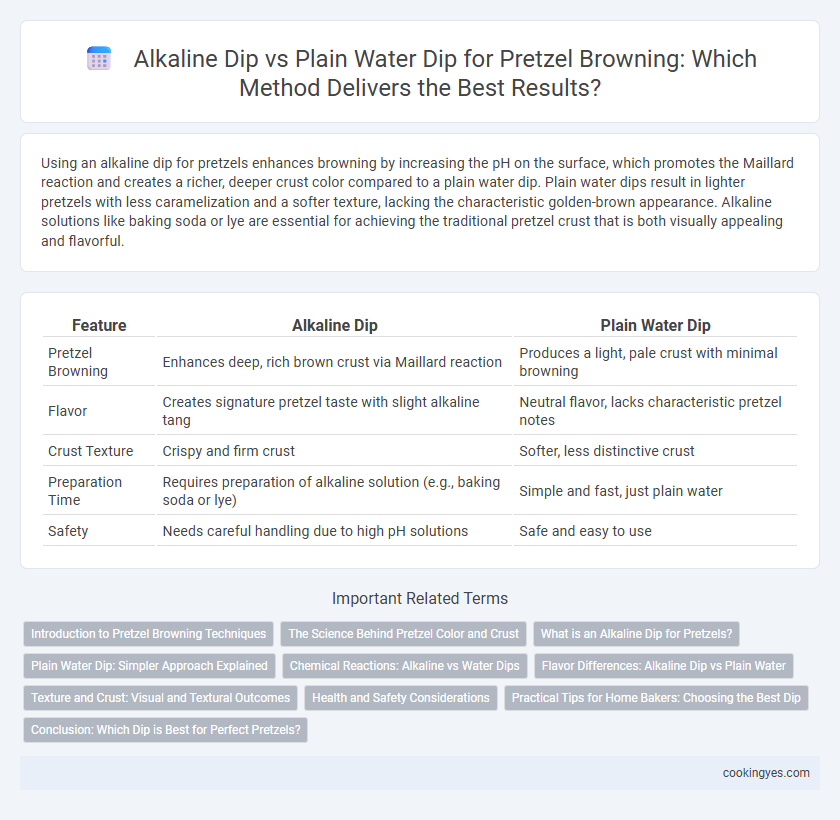Using an alkaline dip for pretzels enhances browning by increasing the pH on the surface, which promotes the Maillard reaction and creates a richer, deeper crust color compared to a plain water dip. Plain water dips result in lighter pretzels with less caramelization and a softer texture, lacking the characteristic golden-brown appearance. Alkaline solutions like baking soda or lye are essential for achieving the traditional pretzel crust that is both visually appealing and flavorful.
Table of Comparison
| Feature | Alkaline Dip | Plain Water Dip |
|---|---|---|
| Pretzel Browning | Enhances deep, rich brown crust via Maillard reaction | Produces a light, pale crust with minimal browning |
| Flavor | Creates signature pretzel taste with slight alkaline tang | Neutral flavor, lacks characteristic pretzel notes |
| Crust Texture | Crispy and firm crust | Softer, less distinctive crust |
| Preparation Time | Requires preparation of alkaline solution (e.g., baking soda or lye) | Simple and fast, just plain water |
| Safety | Needs careful handling due to high pH solutions | Safe and easy to use |
Introduction to Pretzel Browning Techniques
Alkaline dips, typically using a baking soda or lye solution, enhance pretzel browning by promoting Maillard reactions that create a rich, distinctive crust. Plain water dips do not significantly alter pretzel color or texture, resulting in lighter, less flavorful browning. The choice of dipping solution directly affects the phenolic compounds and surface pH, crucial factors in achieving the characteristic golden-brown pretzel appearance.
The Science Behind Pretzel Color and Crust
Pretzel browning is primarily influenced by the Maillard reaction, which occurs when amino acids and reducing sugars interact at high temperatures, producing a rich brown crust and complex flavors. An alkaline dip, typically a lye or baking soda solution with a pH around 11-12, enhances this reaction by increasing the surface pH, promoting deeper browning and a distinct pretzel crust. In contrast, dipping pretzels in plain water results in a milder crust coloration and less pronounced flavor due to the lower surface alkalinity and reduced Maillard reaction efficiency.
What is an Alkaline Dip for Pretzels?
An alkaline dip for pretzels typically consists of a lye solution or baking soda bath that raises the dough's pH level, promoting the Maillard reaction during baking. This chemical reaction is responsible for the pretzel's characteristic deep brown crust and distinct flavor. Unlike plain water dips, alkaline dips enhance browning intensity and create the unique chewy texture associated with traditional pretzels.
Plain Water Dip: Simpler Approach Explained
Plain water dip offers a simpler approach to pretzel browning by providing moisture that activates the Maillard reaction without altering flavor profiles. Unlike alkaline dips, which raise surface pH to enhance browning and develop a distinct crust, water allows for natural caramelization and a softer crust texture. This method suits those seeking a straightforward technique with minimal ingredient use while still achieving an appealing golden finish.
Chemical Reactions: Alkaline vs Water Dips
Alkaline dips, commonly using a baking soda solution, promote the Maillard reaction on pretzel surfaces, intensifying browning and creating a distinctive deep brown crust due to increased pH levels that accelerate protein-sugar interaction. Plain water dips lack the alkaline environment, resulting in minimal Maillard reaction and consequently a lighter, less flavorful crust. The chemical contrast between alkaline and water dips significantly influences the pretzel's texture, color, and flavor profile through their effect on surface chemistry during baking.
Flavor Differences: Alkaline Dip vs Plain Water
An alkaline dip, typically a lye or baking soda solution, enhances pretzel browning by triggering the Maillard reaction, resulting in a deeper mahogany crust and a distinct, slightly tangy flavor profile. Plain water dip produces a lighter, less complex crust with minimal browning and a subtler taste, lacking the characteristic pretzel tang. The alkaline solution not only intensifies color but also imparts a savory depth that plain water cannot achieve.
Texture and Crust: Visual and Textural Outcomes
Alkaline dip enhances pretzel browning by promoting the Maillard reaction, resulting in a deep brown, glossy crust and a firm, chewy texture. Plain water dip yields a lighter color with a softer crust and less pronounced chewiness, due to the absence of alkaline-induced browning. The alkaline bath also contributes to the characteristic flavor and crisp exterior that define traditional pretzels.
Health and Safety Considerations
Alkaline dip, commonly a lye solution, enhances pretzel browning through the Maillard reaction but requires strict handling precautions due to its caustic nature, posing potential chemical burns if improperly managed. Plain water dip is safer for health and safety as it eliminates chemical hazards; however, it results in less pronounced browning and a milder crust flavor. Food establishments must prioritize protective equipment and training when using alkaline dips to ensure worker safety and food compliance standards.
Practical Tips for Home Bakers: Choosing the Best Dip
Using an alkaline dip, such as a baking soda solution, significantly enhances pretzel browning by promoting the Maillard reaction, resulting in a deep, glossy crust. Plain water dips produce softer, lighter pretzels but lack the characteristic pretzel color and texture. Home bakers aiming for authentic pretzel appearance and flavor should prioritize alkaline dips for superior browning and a traditional finish.
Conclusion: Which Dip is Best for Perfect Pretzels?
Alkaline dip, typically a baking soda or lye solution, enhances pretzel browning by triggering the Maillard reaction, producing the signature deep brown crust and distinctive flavor. Plain water dip results in less browning and a softer crust, lacking the complex texture and taste ideal for traditional pretzels. For perfect pretzels with optimal color, flavor, and texture, the alkaline dip is the best choice.
Alkaline dip vs plain water dip for pretzel browning Infographic

 cookingyes.com
cookingyes.com